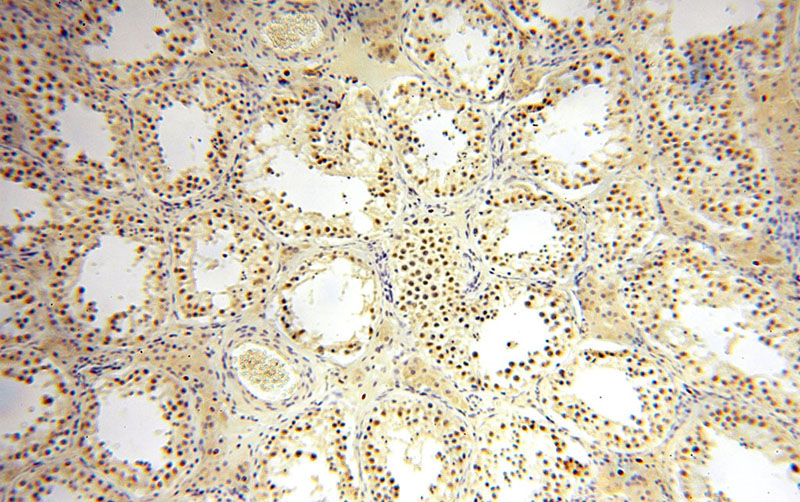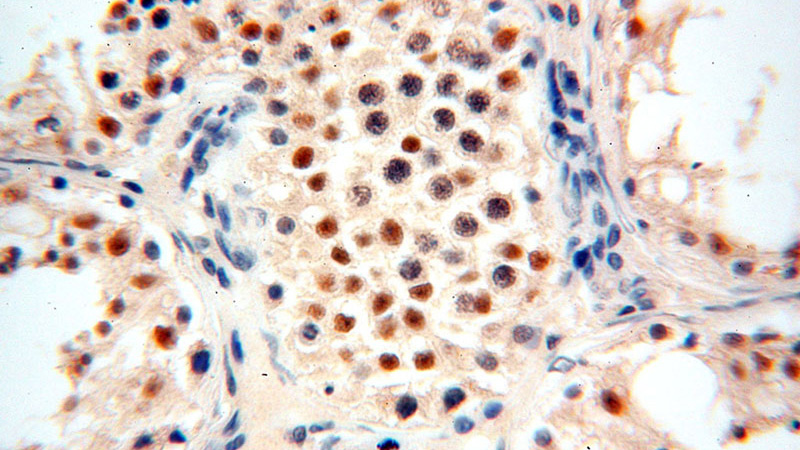-
Product Name
ERCC1 antibody
- Documents
-
Description
ERCC1 Rabbit Polyclonal antibody. Positive IHC detected in human testis tissue, human brain tissue, human ovary tissue, human skin tissue, human spleen tissue. Positive IP detected in MCF-7 cells. Positive WB detected in MCF7 cells, COLO 320 cells, human kidney tissue, SKOV-3 cells. Observed molecular weight by Western-blot: 36-38kd
-
Tested applications
ELISA, WB, IHC, IP
-
Species reactivity
Human,Mouse,Rat; other species not tested.
-
Alternative names
COFS4 antibody; ERCC1 antibody; UV20 antibody
-
Isotype
Rabbit IgG
-
Preparation
This antibody was obtained by immunization of ERCC1 recombinant protein (Accession Number: NM_001369408). Purification method: Antigen affinity purified.
-
Clonality
Polyclonal
-
Formulation
PBS with 0.02% sodium azide and 50% glycerol pH 7.3.
-
Storage instructions
Store at -20℃. DO NOT ALIQUOT
-
Applications
Recommended Dilution:
WB: 1:500-1:5000
IP: 1:200-1:1000
IHC: 1:20-1:200
-
Validations

MCF7 cells were subjected to SDS PAGE followed by western blot with Catalog No:110407(ERCC1 antibody) at dilution of 1:300

Immunohistochemical of paraffin-embedded human testis using Catalog No:110407(ERCC1 antibody) at dilution of 1:50 (under 10x lens)

Immunohistochemical of paraffin-embedded human testis using Catalog No:110407(ERCC1 antibody) at dilution of 1:50 (under 40x lens)

IP Result of anti-ERCC1 (IP:Catalog No:110407, 3ug; Detection:Catalog No:110407 1:300) with MCF-7 cells lysate 1600ug.
-
Background
Excision Repair Cross Complementing 1 (ERCC1) is a structure-specific endonuclease that is responsible for the 5'-incision during DNA repair. It forms a complex with ERCC11, XPF and ERCC4, which are required in both recombinatorial repair and nucleotide excision repair. It has been found that ERCC1, together with RRM1, are determinants of survival after surgical treatment of early-stage, non-small-cell lung cancer. (Ref: Simon, ER. 2005)
-
References
- Dong H, Shi Q, Song X. Polychlorinated biphenyl quinone induces oxidative DNA damage and repair responses: The activations of NHEJ, BER and NER via ATM-p53 signaling axis. Toxicology and applied pharmacology. 286(1):10-6. 2015.
Related Products / Services
Please note: All products are "FOR RESEARCH USE ONLY AND ARE NOT INTENDED FOR DIAGNOSTIC OR THERAPEUTIC USE"
